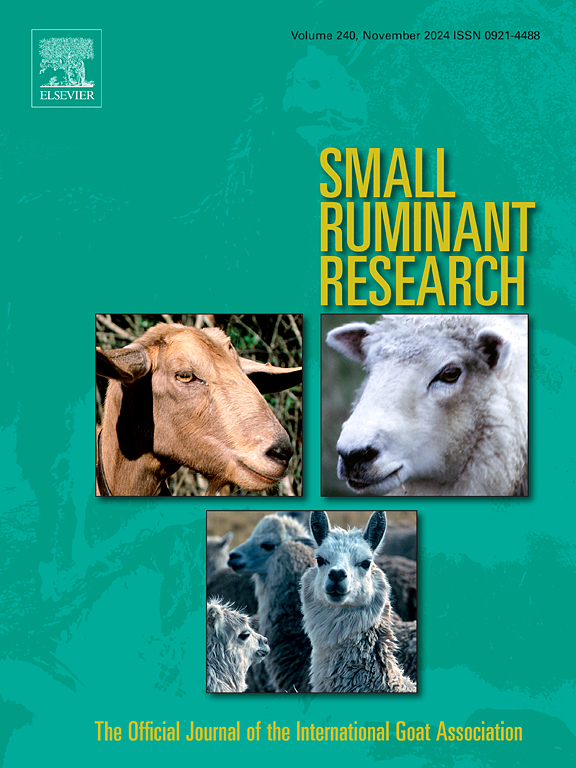Characteristics of indigenous goats and the effects of crossbreeding on goat performance for rural livelihoods sustainability
IF 1.6
3区 农林科学
Q2 AGRICULTURE, DAIRY & ANIMAL SCIENCE
引用次数: 0
Abstract
The study aimed to determine the effects of crossbreeding of Mashona with Boer and Kalahari buck breeds on the growth and efficiency characteristics of goats in Gokwe North District, Zimbabwe. A total of 152 participants already engaged in goat farming were purposively selected. Data on flock structure, management, breeding practices, and performance of goats were assessed in a completely randomized design (CRD) with sire breed (Boer, Kalahari, Mashona), sex (male, female) and damage (12mo, 24 mo) as fixed factors. The results showed that the sex of the kid, dam age and sire breed influenced (P < 0.05) both pre- and post-weaning traits. Crossbreeding increased birth weight (BWT), weaning weight (WWT), weight at six months (WT6), yearling weight (WT12) and weight at first mating (WFM) by 0.5 kg, 7 kg, 13.4 kg, 5.5 kg and 9.9 kg respectively, while improving average daily gains (ADG) from 0 – 3mo (ADG0–3) and 3–6mo (ADG3–6), but ADG from 6 to 12mo (ADG6–12) was lower in crossbred animals than indigenous kids (P < 0.05). The Kleiber ratio (KR) KR1, KR2, gross energy (GE0–3), and GE3–6 improved by 4.8, 2.12, 14, and 17.3, while KR3 and GE6–12 decreased by 2.1 and 34.4 respectively, crossbreeding also reduced the weaning age (WA) by 10 days. Robust positive correlations were observed between BWT and WWT, WT6 and WT12 while WA showed weak but positive correlations with BWT, WFM, WT6 and WT12. Weight at first mating showed the highest positive correlation (r = 0.95) with WT12. The Boer x Mashona kids showed higher heterosis values for BWT and WFM while Kalahari x Mashona kids showed superiority for WT6, WWT and WA. The Kalahari × Mashona cross appears to be a more suitable choice for improving productivity under semi-arid and savanna conditions due to its better growth, efficiency, and adaptation traits.
本地山羊的特点及杂交对山羊生产性能的影响,对农村生计的可持续性
该研究旨在确定马绍纳与布尔和喀拉哈里品种杂交对津巴布韦Gokwe北区山羊生长和效率特性的影响。共有152名已经从事山羊养殖的参与者被有意选择。采用完全随机设计(CRD),以母羊品种(布尔山羊、卡拉哈里山羊、马绍纳山羊)、性别(公山羊、母山羊)和损害(12月龄、24月龄)为固定因素,评估山羊的羊群结构、管理、饲养方法和生产性能数据。结果表明:犊牛性别、母畜年龄和父系品种对断奶前后性状均有影响(P <; 0.05)。杂交使杂交动物的初生重(BWT)、断奶重(WWT)、6月龄重(WT6)、初生重(WT12)和初交重(WFM)分别提高了0.5 kg、7 kg、13.4 kg、5.5 kg和9.9 kg,提高了0 - 3月龄(ADG0-3)和3 - 6月龄(ADG3-6)的平均日增重(ADG),但6 - 12月龄(ADG6-12)的平均日增重(ADG)低于本地仔(P <; 0.05)。克莱伯比(KR)、KR1、KR2、总能(GE0-3)和GE3-6分别提高了4.8、2.12、14和17.3,KR3和GE6-12分别降低了2.1和34.4,杂交还使断奶日龄(WA)降低了10 d。BWT与WWT、WT6、WT12呈显著正相关,WA与BWT、WFM、WT6、WT12呈显著正相关。初交体重与WT12呈显著正相关(r = 0.95)。布尔与马绍纳杂交后代在BWT和WFM方面表现出较高的杂种优势值,喀拉哈里与马绍纳杂交后代在WT6、WWT和WA方面表现出优势。Kalahari × Mashona杂交组合具有较好的生长、效率和适应性,是半干旱和热带草原条件下提高生产力的更合适的选择。
本文章由计算机程序翻译,如有差异,请以英文原文为准。
求助全文
约1分钟内获得全文
求助全文
来源期刊

Small Ruminant Research
农林科学-奶制品与动物科学
CiteScore
3.10
自引率
11.10%
发文量
210
审稿时长
12.5 weeks
期刊介绍:
Small Ruminant Research publishes original, basic and applied research articles, technical notes, and review articles on research relating to goats, sheep, deer, the New World camelids llama, alpaca, vicuna and guanaco, and the Old World camels.
Topics covered include nutrition, physiology, anatomy, genetics, microbiology, ethology, product technology, socio-economics, management, sustainability and environment, veterinary medicine and husbandry engineering.
 求助内容:
求助内容: 应助结果提醒方式:
应助结果提醒方式:


